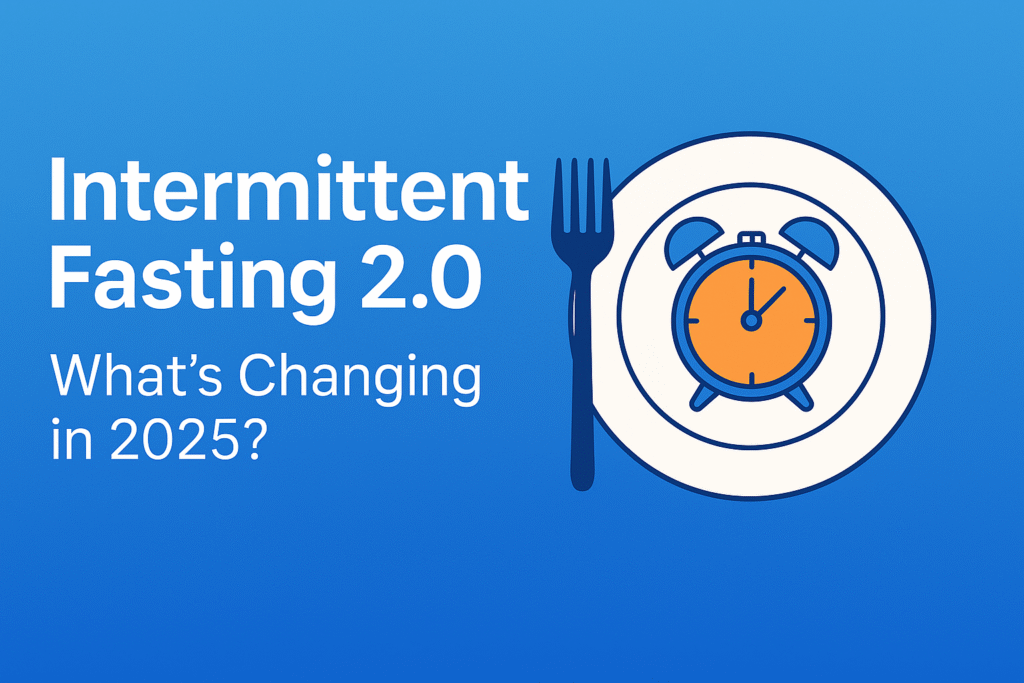Introduction: Why Intermittent Fasting Isn’t the Same in 2025
Intermittent fasting (IF) has evolved far beyond the basic 16:8 or 5:2 routines. With new scientific research, wearable tech, and personalized fasting protocols, 2025 marks the rise of Intermittent Fasting 2.0—a smarter, data-driven way to approach metabolic health and weight management.
In this post, we’ll explore what’s new in IF, how it’s changing with technology, and what experts say about adopting it in 2025.
What Is Intermittent Fasting 2.0?
Intermittent Fasting 2.0 isn’t just about skipping breakfast. It’s a personalized and flexible approach that adapts to your body’s circadian rhythm, metabolism, and even your gut microbiome. It’s less restrictive and more bio-individual—meaning no one-size-fits-all.
In 2025, IF is powered by apps, glucose monitors, and AI-driven food planning tools.
What’s Changing in 2025?
1. Circadian-Based Fasting Gains Ground
New studies support early time-restricted feeding (eTRF)—eating between 6 AM and 2 PM—to align with your body’s internal clock.
According to a Harvard Medical School study, syncing meals with circadian rhythms improves insulin sensitivity and longevity.
2. Smart Tech and Glucose Monitoring
In 2025, fasting isn’t guesswork. Continuous glucose monitors (CGMs) help users understand how foods impact blood sugar and when to break fasts.
- Apps like Zero, Lumen, and Levels Health now offer real-time feedback on metabolic state and meal timing.
Check out Levels Health to see how CGM tech is redefining nutrition.
3. Fasting for Gut Health
A major update in 2025 is the focus on microbiome timing. New protocols combine fasting with probiotic-rich diets to improve gut health and reduce inflammation.
4. Custom Fasting Plans Using AI
AI-driven health apps now offer personalized fasting schedules based on:
- Sleep patterns
- Menstrual cycles
- Physical activity
- Stress levels
This means better compliance and fewer side effects like fatigue or mood swings.
5. Shorter, Smarter Fasting Windows
Not everyone needs 16:8 or OMAD (One Meal A Day). Now, protocols like:
- 12:12 Fasting for Beginners
- 14:10 for Weight Maintenance
- Alternate Day Fasting for Metabolic Reset
are gaining popularity with scientific backing.
Read more on evolving fasting methods from Johns Hopkins Medicine.
Benefits of Intermittent Fasting 2.0
- Improved insulin sensitivity
- Reduced inflammation and oxidative stress
- Increased fat burning and metabolic flexibility
- Enhanced focus and cellular repair (autophagy)
- Better gut health and digestion
Tools to Try in 2025
| Tool/App | Function | Platform |
| Zero | Tracks fasting window & mood | iOS / Android |
| Lumen | Measures breath for fat burning | iOS / Android |
| Levels | Continuous glucose monitoring | Web / Mobile |
| Fastic | Meal and hydration tracking | iOS / Android |
Nutrition Tips While Fasting
- Focus on high-fiber, protein-rich meals to stay full longer
- Break fasts with low-GI foods to avoid blood sugar spikes
- Add electrolytes and herbal teas during fasting hours
Expert Opinions on IF 2.0
“Intermittent fasting is no longer a diet—it’s a metabolic therapy that can be optimized through tech and personalized biology.”
– Dr. Rhonda Patrick, Nutritional Biochemist
Final Thoughts
Intermittent Fasting 2.0 in 2025 is smarter, safer, and more customizable than ever. Whether you’re fasting for weight loss, energy, or longevity, the tools and science now allow you to fast with precision and purpose.
















